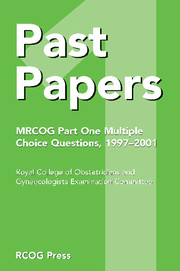Book contents
- Frontmatter
- Contents
- Introduction
- March 1997 – Paper 1
- March 1997 – Paper 2
- September 1997 – Paper 1
- September 1997 – Paper 2
- March 1998 – Paper 1
- March 1998 – Paper 2
- September 1998 – Paper 1
- September 1998 – Paper 2
- March 1999 – Paper 1
- March 1999 – Paper 2
- September 1999 – Paper 1
- September 1999 – Paper 2
- March 2000 – Paper 1
- March 2000 – Paper 2
- September 2000 – Paper 1
- September 2000 – Paper 2
- March 2001 – Paper 1
- March 2001 – Paper 2
- September 2001 – Paper 1
- September 2001 – Paper 2
- Index
March 1997 – Paper 2
Published online by Cambridge University Press: 05 July 2014
- Frontmatter
- Contents
- Introduction
- March 1997 – Paper 1
- March 1997 – Paper 2
- September 1997 – Paper 1
- September 1997 – Paper 2
- March 1998 – Paper 1
- March 1998 – Paper 2
- September 1998 – Paper 1
- September 1998 – Paper 2
- March 1999 – Paper 1
- March 1999 – Paper 2
- September 1999 – Paper 1
- September 1999 – Paper 2
- March 2000 – Paper 1
- March 2000 – Paper 2
- September 2000 – Paper 1
- September 2000 – Paper 2
- March 2001 – Paper 1
- March 2001 – Paper 2
- September 2001 – Paper 1
- September 2001 – Paper 2
- Index
Summary
1. The following changes in ventilation occur during pregnancy:
A. a decrease in respiratory rate.
B. a decrease in Pco2.
C. a decrease in residual volume.
D. an increase in tidal volume.
E. an increase in Po2.
2. The following are required for haemostatic clot formation:
A. conversion of prothrombin to thrombin.
B. platelet phospholipids.
C. active conversion of plasminogen to plasmin.
D. fibrin degradation products.
E. antithrombin.
3. Myometrial contractility
A. is calcium-dependent.
B. is associated with phosphorylation of myosin light chain.
C. is independent of cyclic adenosine monophosphate (CAMP).
D. is mediated by somatic nerves.
E. depends on myometrial gap junctions.
4. The following values fall within the normal range for the adult female bladder:
A. residual urine of 100 ml.
B. voiding volume of 250 ml.
C. bladder capacity of 900 ml.
D. intravesical pressure rise of less than 10 cm H2O during early filling.
E. maximum urine flow rate of 60 ml per second.
5. The parenchymal cells of the liver
A. can convert fructose to glucose.
B. synthesise urea.
C. conjugate bilirubin.
D. excrete bromsulphthalein.
E. synthesise cholesterol.
6. In the testis,
A. maturation from spermatogonia to spermatozoa takes about 29 days.
B. Sertoli cells can mature into spermatids.
C. Leydig cells produce inhibin.
D. luteinising hormone inhibits the secretion of testosterone.
E. large quantities of fructose are present in seminal fluid.
- Type
- Chapter
- Information
- Past Papers MRCOG Part One Multiple Choice Questions1997–2001, pp. 11 - 20Publisher: Cambridge University PressPrint publication year: 2004



